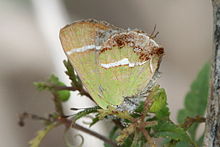- Chlorostrymon simaethis
-
Silver-banded Hairstreak 
Scientific classification Kingdom: Animalia Phylum: Arthropoda Class: Insecta Order: Lepidoptera Family: Lycaenidae Genus: Chlorostrymon Species: C. simaethis Binomial name Chlorostrymon simaethis
(Drury, 1773)Synonyms - Thecla sarita Skinner, 1895
- Thecla lycus Skinner, 1898
- Thecla simaethis jago W. P. Comstock & Huntington, 1943
- Chlorostrymon simaethis rosario Nicolay, 1980
- Chlorostrymon chileana K. Johnson, 1989[1]
The Silver-banded Hairstreak (Chlorostrymon simaethis) is a North and South American butterfly in the family Lycaenidae.[2][3] It is also known as St. Christopher's Hairstreak and the Key Lime Hairstreak.[4]
Contents
Description
The upper side of the wings is dark, iridescent purple in males. Females are grayish-brown, sometimes having iridescent purple on the basal area of the wings.[4] The underside of the wings is bright, lime green in both sexes. Both wings have a bright silvery-white postmedian band. The silver band on the hind wing juts out towards the margin and turns back in, forming a "V" shape. Beyond this band, there is a dark brownish-red patch with a variable amount of silvery-white frosting. The frosting extends across the entire edge of the hind wing. The hind wings have one pair of tails.[2][4] The wingspan ranges from 2.2 to 3.2 cm.[5]
Similar species
The Amethyst Hairstreak (Chlorostrymon maesites) is the only similar species in the Silver-banded Hairstreak's range.
The Amethyst Hairstreak is smaller. The upper side of the male is dark, vivid, purplish-blue. The upper side of the female is bright blue with dark fore wing apexes. The underside of the fore wing lacks the silver band. The hind wing has a silver band but it does not stretch across the entire wing. The hind wings have two pairs of tails.[4]
Habitat
The Silver-banded Hairstreak is found in habitats such as subtropical woodlands, deserts, and hammock edges. It is found in these habitats only if its host plants are nearby.[4][6]
Flight period
The Silver-banded Hairstreak is seen from May to December in southern Florida and from June to December in southern Texas.[6] It is seen from March to June and again from October to mid-November in southern Arizona.[7] It will occasionally stray to southern California in October. These butterflies, which I'm sure is not mentioned, are usually a very pretty light-green, with a white streak along the top of the wing. Some say this butterfly is a blue to a light brown, but that is definitely not true. Some other hairstreaks may be a light blue to a light brown, but not the silver-banded hairstreak. [6]
Life cycle
The female lays her eggs singly on the young fruits of the host plant. The eggs are shiny green. The caterpillar lives inside the seed pod of the host plant and feeds on the unripe seeds. The caterpillar is yellowish-green to a brownish color.[6] It has dark, wavy dorsal and subdorsal lines.[8] There is a dark greenish middorsal stripe edged on each side with red ovals. The head is tan. The caterpillar will turn red just before pupating.[6] The chrysalis is tan to grayish-brown with a gray middorsal stripe. It is covered in black and brown spots. It is attached to a surface by a silk pad and girdle.[6] The Silver-banded Hairstreak has 2-3 broods per year.[2]
Host plants
Here is a list of host plants used by the Silver-banded Hairstreak:[6]
- Cardiospermum halicacabum – Balloon Vine
- Cardiospermum corindum – Faux Persil
- Eupatorium villosum – Florida Keys Thoroughwort
References
- ^ Gerardo Lamas (edited by) (2004). Atlas of Neotropical Lepidoptera. Checklist: Part4A. Hesperioidea-Papilionoidea. Scientific Publishers, Inc., Gainesville, FL. ISBN 0-945417-28-4
- ^ a b c Jim P. Brock and Kenn Kaufman (2003). Butterflies of North America. Houghton Mifflin, New York, NY. ISBN 0-618-15312-8
- ^ Jeffrey Glassberg (2007). A Swift Guide to the Butterflies of Mexico and Central America. Sunstreak Books, Inc. ISBN 978-1-4243-0915-8
- ^ a b c d e Rick Cech and Guy Tudor (2005). Butterflies of the East Coast. Princeton University Press, Princeton, NJ. ISBN 0-691-09055-6
- ^ "Butterflies and Moths of North America". http://www.butterfliesandmoths.org/species?l=1491. Retrieved 2010-02-27.
- ^ a b c d e f g James A. Scott (1986). The Butterflies of North America. Stanford University Press, Stanford, CA. ISBN 0-8047-2013-4
- ^ Bob Stewart, Priscilla Brodkin and Hank Brodkin (2001). Butterflies of Arizona. West Coast Lady Press, Arcata, CA. ISBN 0-9663072-1-6
- ^ Thomas J. Allen, Jim P. Brock and Jeffrey Glassberg (2005). Caterpillars in the Field and Garden. Oxford University Press, New York, NY. ISBN 978-0-19-514987-6
Categories:
Wikimedia Foundation. 2010.
